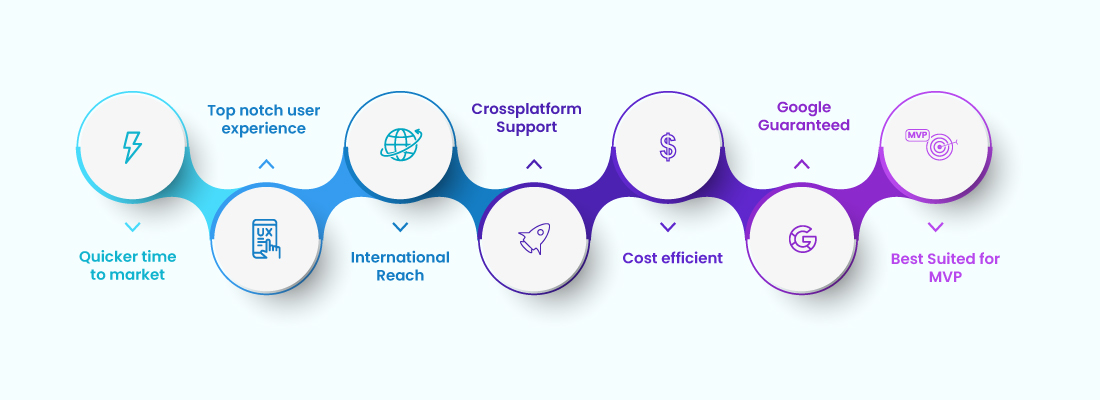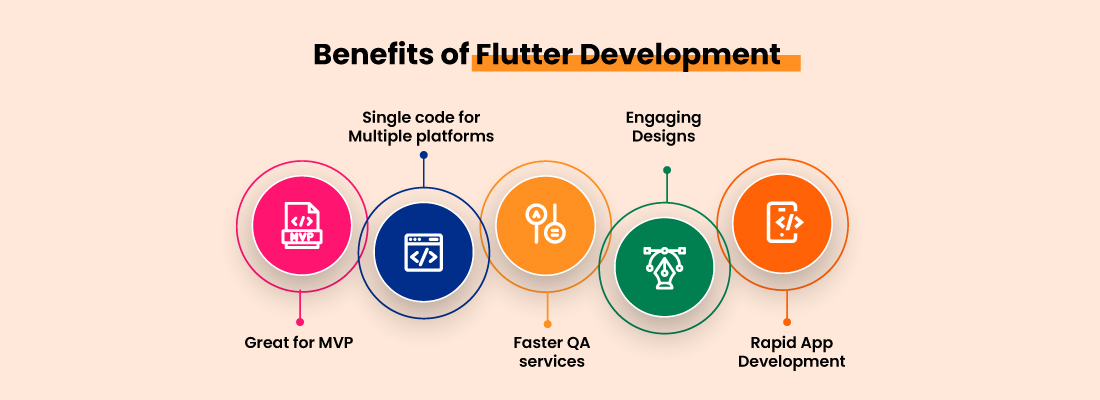The Flutter app development is a solution focused on building cross-platform apps in record time.
It is perfect for small businesses and startups that have no time to waste.
But, is Flutter the best solution? What are its pros and cons?
This blog will help you know whether Flutter is the best solution for your business.
If you’re an expert mobile app developer, you’ve probably already decided whether to create apps for Android or iOS devices.
If you’re just starting, you may still be debating your chosen platform.
On your route to becoming a cross-platform or mobile app developer, these choices will define which technologies you should master.
Flutter is a wise pick no matter where you want to go with your app development adventure.
This book will provide you with an overview of Flutter, discuss its benefits and drawbacks, and go over what you can create using this free and open-source software development kit.

What is Flutter? – Pros and cons of the flutter app development
To create stunning native user interfaces, or UIs, from a single codebase, Google created the open-source UI toolkit known as Flutter.
So, apps created using Flutter may be used on Android, iOS, and the web.
Dart is used to creating the Flutter framework. The object-oriented programming language Dart is current.
If you are familiar with any other programming language, such as JavaScript, you can learn it quickly.
With the release of Flutter 3.0, it is now feasible to create desktop and online applications even though it was initially developed primarily for creating cross-platform apps.
What can you build with Flutter?
Now that Flutter 2.0 is out, you can create the following:
- Android and iOS cross-platform mobile applications
- Single-page apps (SPAs), Progressive Web Apps (PWAs), and the web-based expansion of current Flutter mobile apps
- Desktop applications using Flutter 3.0 on Windows, Mac, and Linux.
What makes Flutter unique? – Pros and cons of the flutter app development
If you’ve ever created a mobile application with the help of a cross-platform framework your code, whether written in Xamarin or React Native, will go through a bridge or switch that, before it is rendered on the device, compiles it into a Webview using JavaScript.
Flutter, on the other hand, renders apps natively rather than delegating that responsibility to the platform. To render widgets on the screen, access events like taps, and use services like the camera, all Flutter needs is a canvas.
By turning the code into native ARM code, Flutter targets the ARM of the targeted system by utilizing Dart’s just-in-time and forward compilation abilities.
Flutter apps become much faster and more responsive as a result, improving consistency.

Pros
Here are a few explanations for why Flutter is swiftly overtaking competing cross-platform frameworks like React Native, Xamarin, and NativeScript in popularity.
Flutter consistency
The idea of “write once, run anywhere” is arguably Flutter’s biggest selling point.
Maintaining consistency across Android, iOS, and the web is not a concern.
All of it is handled by a single codebase, which reduces resource usage, speeds up build times, and makes code maintenance easier.
Stateful hot reload
High developer velocity is produced by stateful hot reloading.
When code changes are made, Flutter gives a quick UI refresh. The just-in-time compiler makes this possible.
Community support
In terms of GitHub stars at the time of writing, Flutter has surpassed React Native.
This may mean that Flutter is becoming more popular among developers than React Native.
Additionally, more Flutter-related queries on Stack Overflow were posted in 2020 than React Native-related ones.
This suggests that more programmers want to find out more about Flutter.
Open source
Because Flutter is an open-source framework, you can view the original coding that was used to create it.
As a result, you may assist the Flutter community by making contributions and reporting bugs.
The open-source community has contributed to some of the biggest advancements in the software development field.
Faster app development
With Flutter, creating cross-platform applications is considerably simpler.
Widgets that are already included speed up the process of developing, testing, and fixing apps.
Flutter is useful for creating an MVP and quick prototyping.
Cons
There aren’t many drawbacks to adopting Flutter for cross-platform app development in comparison to the positives.
However, it’s important to take into account the relative youth and constraints of the framework while choosing which one is appropriate for your project.
Consider the potential drawbacks listed below.
Emerging framework
Flutter is still a young framework, even though the community of cross-platform developers is beginning to take notice of it.
This suggests that there aren’t many learning resources available, and there aren’t many plugins and packages either.
Limited plugins/packages
Compared to React Native, Flutter provides fewer packages and plugins.
This is reasonable given the framework’s youth; the first stable version of Flutter was made available on December 4, 2018.
As additional plugins and packages for Flutter are created by the community, the effects of this restriction should gradually reduce.
Over 26K packages already exist to facilitate the development of Flutter apps, and the number is continuously rising.
App size
The size of the final app is often greater because Flutter uses built-in widgets rather than platform widgets.
The download time and storage requirements for larger apps are longer.
Nevertheless, using particular libraries and packages, asset compression, and the deletion of unneeded resources can all aid in shrinking the size of the Flutter project.
Smaller Dart community
In comparison to JavaScript, the programming language used to create Flutter apps, Dart has a much smaller developer community.
As a result, there aren’t many resources available to teach you, Dart, just like there aren’t many for the Flutter framework itself.
Final thoughts
Flutter has developed into a portable framework for creating apps for a variety of platforms, including Android, iOS, the web, and desktop (Windows, Mac, Linux).
It converts your code to machine code, which makes Flutter quick.
Flutter provides developers with the flexibility they need to design stunning user experiences thanks to stateful hot reload, which boosts developer productivity.
Finally, because Flutter uses a single codebase, you don’t have to worry about how your app’s user interface will look on Android, iOS, or the web.
If you have Flutter app development requirements connect with Yugasa Software Labs.
Read More: 7 FACTORS THAT MADE FLUTTER THE BEST PLATFORM FOR BUILDING STARTUP MOBILE APPS
























